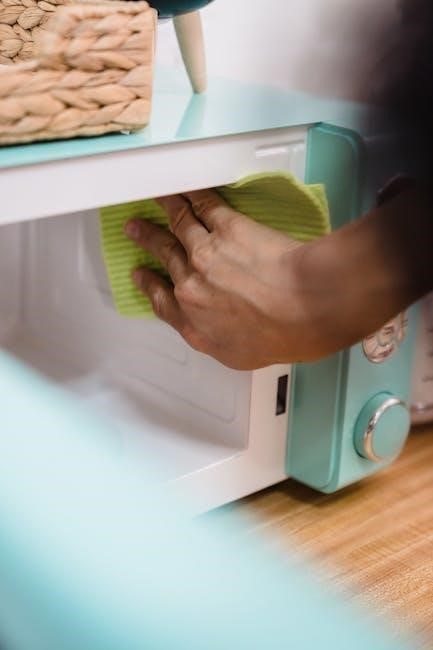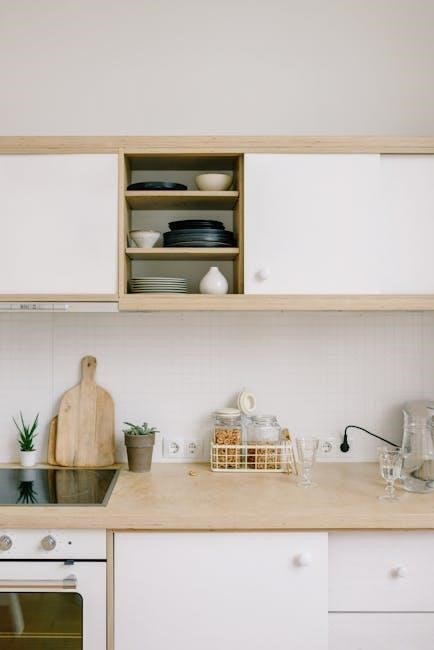Preparing the Oven for Manual Cleaning
Start by ensuring the oven is completely cool for safety and effectiveness. Remove all racks and shelves‚ and empty the oven cavity to begin manual cleaning properly.
1.1. Ensure the Oven is Cool
Turn off the oven and allow it to cool completely before starting the manual cleaning process. A cool oven ensures safety and prevents burns or damage to surfaces. Open the oven door slightly to speed up the cooling process. Never attempt to clean a hot oven‚ as this can lead to accidents or ineffective cleaning results. Waiting for the oven to cool is an essential first step for a safe and successful manual cleaning experience.
1.2. Remove Oven Racks and Shelves
Take out all racks and shelves from the oven cavity to clean them separately. Use gloves to protect your hands from sharp edges. Place the racks in a sink or large container filled with hot soapy water to soak. This step ensures thorough cleaning and prevents food residue from burning onto surfaces during the cleaning process. An empty oven cavity also allows better access for manual cleaning methods.

Cleaning the Oven Racks
Clean oven racks by soaking them in hot soapy water or using a baking soda paste. Scrub thoroughly to remove grease and food residue effectively.
2.1. Soak the Racks
Soak oven racks in hot soapy water or a baking soda paste to loosen tough stains. This method helps break down grease and food residue‚ making scrubbing easier. Ensure racks are fully submerged and left overnight for best results. Always wear gloves and ensure good ventilation when handling cleaning solutions.
2.2. Scrub the Racks
After soaking‚ use a gentle scrubber or non-abrasive sponge to remove food residue and grease from the racks. For tough spots‚ a soft-bristle brush can be effective. Avoid using harsh chemicals or abrasive cleaners‚ as they may damage the finish. Rinse thoroughly with clean water and dry with a microfiber cloth to prevent water spots. Regular scrubbing helps maintain cleanliness and prevents heavy buildup over time.

Applying a Cleaning Paste
Apply a thin paste of 3 tablespoons water and 1 cup baking soda inside the oven cavity‚ covering all surfaces evenly for effective cleaning.
3.1. Mix Baking Soda and Water
Combine 1 cup of baking soda with 3 tablespoons of water to form a smooth‚ spreadable paste. This mixture is ideal for covering oven surfaces without dripping or running off.
3.2; Let it Sit Overnight
After applying the baking soda paste‚ allow it to sit undisturbed overnight. This extended time enables the paste to penetrate and loosen tough grime and food residue effectively. By morning‚ the residue will be significantly softened‚ making it easier to wipe away. The overnight soak also helps neutralize oven odors‚ ensuring a fresh and clean result when you finish wiping down the surfaces.
Utilizing Vinegar for Cleaning
For a natural and effective clean‚ mix equal parts water and vinegar in a heat-safe dish. Place it in the oven‚ heat to create steam‚ and let it loosen grime naturally.
4.1. Spray Vinegar Inside the Oven
Mix equal parts water and white vinegar in a spray bottle. Generously spray the interior surfaces of the oven‚ ensuring complete coverage. Allow the solution to sit for about 30 minutes to help loosen grime and food residue. This natural method effectively breaks down tough stains without harsh chemicals‚ preparing the oven for a thorough wipe-down with a damp cloth or sponge.
4.2. Wipe Down Surfaces
Using a microfiber cloth or sponge‚ gently wipe down all interior surfaces‚ focusing on areas with loosened grime from the vinegar solution. Avoid using abrasive scrubbers or harsh chemicals to prevent damage. Pay special attention to racks‚ walls‚ and the oven window. For stubborn stains‚ repeat the vinegar spray and wiping process until the surface is clean. This gentle method ensures a sparkling finish without scratching the oven’s interior.

Steam Cleaning the Oven
Place water and vinegar in a pan‚ then heat the oven to 450°F. The steam will loosen grime‚ making it easier to wipe down surfaces afterward.
5.1. Steam Method
Place a pan of water and vinegar inside the oven‚ then heat it to 450°F. Allow the mixture to steam for about 30 minutes‚ creating a thick vapor that loosens grime; The steam will cover the oven walls‚ softening tough stains and food residue. This method is gentle yet effective‚ preparing the surface for an easy wipe-down without harsh chemicals. It’s ideal for ovens that aren’t excessively dirty‚ making manual cleaning quicker and more manageable.
Considering Ammonia as an Alternative
Place a half cup of household ammonia in a shallow container inside the oven. Let it sit overnight; the fumes will help break down tough grime. Wear gloves and ensure good ventilation for safety. This method is effective for manual cleaning when other techniques fall short‚ leaving the oven ready for a final wipe-down.
6.1. Using Ammonia
Place a shallow container with 1/2 cup of household ammonia inside the cool oven. Allow it to sit overnight; the fumes will break down tough grime. Ensure good ventilation and wear gloves for safety. After letting it sit‚ remove the container and wipe down the oven surfaces with a damp cloth. This method is effective for loosening stubborn stains without harsh scrubbing.
Final Wipe Down and Drying
Use a damp cloth to wipe away remaining residue and moisture. Ensure the oven is completely dry to prevent water spots and maintain a clean finish.
7.1. Damp Cloth Wipe
Using a damp microfiber cloth‚ gently wipe down all interior surfaces to remove any remaining residue or moisture. Ensure the cloth is not soaking wet to avoid water spots. This step helps maintain a clean and streak-free finish after manual cleaning. Avoid using excessive water‚ as it can leave mineral deposits. For tougher residue‚ repeat the process until the oven surfaces are spotless and ready for drying.
7.2. Dry the Oven
After wiping down the oven‚ use a clean‚ dry microfiber cloth to thoroughly dry all surfaces. This prevents water spots and ensures no moisture remains. Allow the oven to air dry with the door slightly open to promote airflow. Regular drying helps maintain the oven’s condition and prevents future residue buildup. Ensure the oven is completely dry before using it again to avoid any steam or moisture issues during cooking.

Cleaning the Oven Exterior
Wipe the exterior with a damp cloth‚ using a mixture of baking soda and vinegar for tough stains. Rinse and dry thoroughly to avoid water spots.
8.1. Exterior Cleaning
For the oven’s exterior‚ mix baking soda and water to create a paste. Apply it to tough stains or grime‚ let it sit for 15-20 minutes‚ then rinse with a damp cloth. For lighter cleaning‚ use a gentle dish soap solution. Avoid abrasive cleaners or scrubbers to prevent scratching. Dry thoroughly with a microfiber cloth to prevent water spots and maintain a polished finish. Regular exterior cleaning keeps your oven looking new and well-maintained.

Safety Precautions
Always wear protective gloves and ensure proper ventilation when cleaning. Avoid using abrasive cleaners or harsh chemicals that could damage surfaces or release harmful fumes during manual cleaning.
9.1. Wear Protective Gloves
Always wear rubber or heat-resistant gloves when manually cleaning your oven to protect your hands from harsh chemicals‚ hot surfaces‚ and sharp edges. Ensure the gloves fit snugly and are resistant to cleaning agents. This precaution prevents skin irritation and burns‚ especially when handling hot racks or scrubbing tough stains. Proper hand protection is essential for a safe and effective cleaning process.
9.2. Ensure Ventilation
Open windows and doors to provide good airflow before and during manual oven cleaning. This helps prevent the buildup of strong fumes from cleaning agents like ammonia or vinegar. Use fans to circulate air and reduce odors. Proper ventilation ensures a safer environment and prevents respiratory discomfort while cleaning. Always prioritize airflow to maintain a well-ventilated space throughout the cleaning process.

Avoiding Abrasive Cleaners
Avoid using abrasive cleaners or scrubbers‚ as they can scratch or damage the oven’s surfaces. Instead‚ opt for gentle cleaning methods like baking soda paste or vinegar solution.
10.1. Use Gentle Methods
Avoid harsh chemicals and abrasive scrubbers‚ as they can damage the oven’s finish. Instead‚ use gentle methods like baking soda paste or vinegar solution to remove grime without scratching surfaces. For tough stains‚ steam cleaning can be effective. Always wipe down with a soft‚ damp cloth or microfiber to maintain the oven’s condition and ensure a safe‚ non-toxic cleaning process that preserves its finish and functionality over time.
